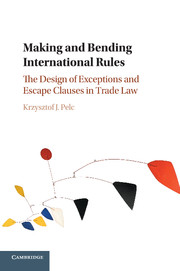Book contents
- Frontmatter
- Dedication
- Contents
- List of Tables
- Acknowledgments
- 1 The “Architectural Challenge” of International Rules
- 2 A Theory of the Design of Flexibility
- 3 A Brief Intellectual History of Flexibility in Law
- 4 The Twin GATT Exceptions: Fears and Solutions
- 5 The Evolving Design of Flexibility
- 6 The Bad News
- 7 The Good News
- 8 The Great Recession and Beyond
- Bibliography
- Index
5 - The Evolving Design of Flexibility
Published online by Cambridge University Press: 05 September 2016
- Frontmatter
- Dedication
- Contents
- List of Tables
- Acknowledgments
- 1 The “Architectural Challenge” of International Rules
- 2 A Theory of the Design of Flexibility
- 3 A Brief Intellectual History of Flexibility in Law
- 4 The Twin GATT Exceptions: Fears and Solutions
- 5 The Evolving Design of Flexibility
- 6 The Bad News
- 7 The Good News
- 8 The Great Recession and Beyond
- Bibliography
- Index
Summary
In Chapter 3, I presented a brief history of flexibility in rules, tracing the treatment of two of its main concepts, necessity and the change of circumstances, through time. I then took a closer look at two sources of exception in the trade regime in Chapter 4, trying to explain the great disparity in countries’ reliance on each. In this chapter, I aim to fill in the picture by providing a sense of the menu of available provisions that governments can turn to in order to suspend their obligations in the trade regime today.
These flexibility provisions all differ from the General Exceptions of Article XX in a couple of ways. First, recall that Article XX relies on an affirmative defense, whereby countries invoke it when faced with a formal challenge, when one of their measures would be in violation of their primary GATT obligations, were it not for how it falls under one of the subparagraphs of Article XX. By contrast, the flexibility provisions I focus on below are taken before any challenge arises. In this sense, they resemble more closely the canonists’ treatment of necessity, where violations that were necessary never became violations: necessity extracted deeds from the law before they could be seen as breaking the rules. Similarly, governments have access to a host of instruments that allow them to actively react to sudden need in a way that would otherwise constitute a transgression of the primary rules.
The second distinction from Article XX is that while the latter allows permanent exceptions conditional on meeting the Article's requirements – a ban on children's toys containing lead paint would be tolerated indeterminately – the flexibility provisions below all have a temporary quality, as they are reactions to exogenous shocks that are thought to have temporary effects. Finally, while I spend more time comparing the record of use of these instruments in the following two chapters, it is worth nothing that countries rely on each of the instruments below with far greater frequency than on Article XX.
I devote most space tracing the evolution in the design of the trade regime's quintessential escape clause, the safeguard.
- Type
- Chapter
- Information
- Making and Bending International RulesThe Design of Exceptions and Escape Clauses in Trade Law, pp. 137 - 205Publisher: Cambridge University PressPrint publication year: 2016



